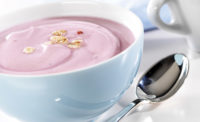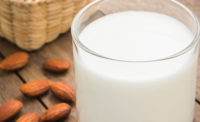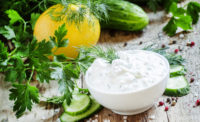Emulsifiers, stabilizers and gums are the unsung heroes of many dairy products. Not only do they create desired textures, but they also help offerings avoid nasty issues such as syneresis and keep their attributes throughout shelf life.
“Stabilizers and emulsifiers can help with freeze/thaw stability, resistance to shrinkage, resistance to syneresis, resistance to serum separation, resistance to creaming, resistance to sedimentation [and] resistance to meltdown, as well as contribute to the overall texture of a finished product,” summarizes Philip Rakes, senior food technologist for Agropur U.S., Eden Prairie, Minn. “In some rare instances, they can even contribute to the nutritional aspects of a finished product.”
According to Iliana Nava, senior technical service specialist, hydrocolloids for Minneapolis-based Cargill, hydrocolloids (which include starches and gums) also are important for keeping products consistent batch to batch when they contain ingredients with variable amounts of solids and minerals.
In frozen desserts, gums and starches serve another functionality, says Matthew Berliner, vice president, ISC Gums, Edison, N.J. These ingredients control melt time, ice crystal size and shelf stability.
And in sour cream and cottage cheese, stabilizers can prevent whey separation, notes Scott Rangus, president and CEO of Ingredients Solutions Inc. (ISI), Waldo, Maine.
Despite their multifaceted roles, emulsifiers, gums and starches are asked to serve another purpose by many of today’s discerning consumers: They should also be clean-label friendly.
What’s in a name?
One of the biggest influences in the emulsifiers/stabilizers/gums space in the past year has been consumers’ interest in products they perceive as “natural” or “less processed,” shares Nava.
“That can create challenges for formulators, as they strive to maintain functionality and achieve their textural goals for finished products,” she adds. “Fortunately, ingredient suppliers like Cargill have been working to address these gaps, introducing a steady stream of highly functional, label-friendly products.”
Eco Guar Group LLC’s 2018 quantitative research study found that 86% of consumers think it is important to understand ingredients on food labels, says Kat Peeler, CEO of the New York-based company.
“Products with additives like carrageenan and xanthan gum are increasingly being rejected by customers due to their perceived artificiality and being linked to potential health problems,” she adds.
According to Corie Beyers, strategic marketing manager, food systems for Westchester, Ill.-based Ingredion Incorporated, one of the challenges here is that there is no universally accepted definition for clean label. Thus, processors need to be “agile and flexible” within a constantly changing market.
“When a developer is looking to clean up their label, it is often contingent on GMO status, organic status, retailer approval and other variables,” she explains.
The clean-label movement also has changed how processors label the ingredients they use. They now often list “the common names of additives on ingredient labels instead of technical names” — for example using “guar gum” instead of “E412,” explains Peeler.
Eco Guar Group’s research also revealed that 69% of consumers thought guar gum didn’t belong on a clean label. However, after learning that it was plant-derived, 77% of consumers believed it to be clean-label friendly.
“A major finding was that consumers strongly preferred the name guar bean gum over guar gum,” says Peeler. “Nearly 90% (88%) believed adding ‘bean’ to the name best communicated the natural origin of guar gum and was the best fit for a clean label.”
After reviewing these findings, Eco Guar Group petitioned the FDA for a name change and won approval to use guar bean gum in labeling.
An Ho, research and development director, and Emily O’Chiu, product development scientist for Fenton, Mo.-based International Food Products Corp., say if the name of an ingredient has an artificial connotation, it can influence consumer perception.
“Xanthan gum is commonly accepted as clean label, but the word xanthan can have a chemical perception,” they note. “Due to the word’s appearance, some consumers will not buy anything with xanthan as an ingredient.”
According to Berliner, consumer perception can make a huge difference, even if it is inaccurate. He points to carrageenan, a stabilizer derived from seaweed that has suffered from “misinformation spread virally” and is still recovering its reputation in the eyes of consumers.
“Right or wrong, it’s difficult to fight consumer perception, and consumer education is a long, expensive and difficult undertaking, especially these days when one tweet from an ‘influencer’ can wrongly inform consumers and create a backlash against an ingredient,” Berliner argues.
Kevin Johndro, director of research and development for ISI, agrees that carrageenan has specifically suffered a backlash.
“[It] has been used safely in commercially marketed products for decades,” he notes. “It has also been under an orchestrated attack by a small group of researchers for several years.”
‘Cleaner’ ingredient offerings
Fortunately for dairy processors looking to clean up their labels, lots of stabilizers, emulsifiers and gums fit the bill. For example, in the emulsifier category, Cargill offers a “more label-friendly” sunflower or canola lecithin, which can be used instead of mono- and diglycerides, says Nava.
“Lecithin will hold the fat and water portions of a frozen-dessert system in place, and it can help control overrun,” she explains.
For its part, The Ingredient House, Southern Pines, N.C., created an emulsifier made from red maple wood that also meets clean-label needs.
“We offer an upcycled plant-based, clean-label emulsifier, humectant and texturizer called Nouravant maple fiber,” says Katherine Cleland, technical manager. “It has shown efficacy as an emulsifier and mono-/diglyceride replacement in some dairy applications.”
Yogurt makers looking for a clean-label stabilizer could turn to pectin, a fiber naturally derived from citrus peels, explains Kyle Bailey, sales technical service manager, Americas for Atlanta-based CP Kelco. The company offers a couple of pectin products meant for different applications. For example, its new GENU Pectin YM-FP-2100 is designed for fruity yogurt drinks.
“[It] is added at the fruit preparation stage and then carries over the stability into the yogurt drink,” Bailey says. “No other starch or stabilizer is needed.”
CP Kelco also created GENU Explorer Pectin ND-200 as a vegetarian substitute for gelatin.
“It has the same creamy, melt-in-your-mouth texture and molding quality to make dairy desserts such as panna cotta and is compatible with traditional processing methods,” Bailey points out.
Another citrus fiber with stabilizing (and emulsifying) properties is Fiberstar’s Citri-Fi — a byproduct created by the citrus juicing process, explains Brock Lundberg, Ph.D., president of R&D and applications for the River Falls, Wis.-based company.
“Due to the high fat- and water-binding capability of Citri-Fi, very small amounts — for example, less than 0.5% — of Citri-Fi will deliver emulsification and stabilization functionality,” he notes, “Citri-Fi also comes in several different particle sizes, which can be useful for formulating different properties such as emulsification, viscosity, creaminess, storage and/or process stability.”
According to Lundberg, the ingredient can be labeled as consumer-friendly “dried citrus pulp” or “citrus flour.”
On the gums front, ISC Gums offers the clean-label option of acacia gum, notes Berliner. It is often used in dairy beverages for its ability to emulsify without adding texture.
“ISC Gums is currently developing an exciting new process, which will produce an acacia that will provide a stronger emulsion at much heavier oil loads,” he says. “This process will not use any chemical modifiers and will be 100% clean label.”
Beyond clean label
Consumer interest in clean labels goes beyond looking for naturally derived ingredients. It can also mean a desire for label designations such as non-GMO and organic, explains Donna Klockeman, director of R&D innovation for Colony Gums Inc., Monroe, N.C.
“In response to increased consumer demand for non-GMO ingredients, we have expanded our TrueGum line of Non-GMO Project Verified gums and stabilizer blends,” she says. “We have also observed increased requests for organic-compliant and our certified Colony Organics product line that includes individual hydrocolloids and stabilizer blends.”
Ingredion also sells a variety of Non-GMO Project Verified gums, says Beyers.
“We currently offer over 60 gum-containing products that carry the Non-GMO Project Verified seal, including acacia, guar, pectin, xanthan and more,” she notes. “We are committed to producing ingredients that allow manufacturers to communicate clearly and honestly with their customers.”
Another reality of the clean-label movement is that consumers are looking for shorter ingredient lists, notes Jennifer Stephens, vice president of marketing for Fiberstar. This has led to processors searching for multifunctional ingredients that can serve more than one purpose in a formulation.
“Very few natural ingredients provide multiple functionality and stability in food processing,” she says. “Citri-Fi is unique in that this citrus fiber provides both high water-holding and emulsification properties.”
According to Bailey, CP Kelco’s dual-function KELCOGEL DF gellan gum, which is meant for dairy beverages, can help shorten ingredients lists.
“It provides suspension power for insolubles like cocoa or minerals, as it enhances mouthfeel,” he explains. “It’s one ingredient that does the work of two.”
And sustainability plays a role in the clean-label picture, too. Consumers not only want to understand what the ingredients are, but also how they are sourced.
“For the dairy processors, a transparent supply chain and traceability from farmer to processor help to ensure product quality and safety,” says Peeler. “Eco Guar Group has a focus on ethical fair trade, traceability and sustainability with industry-leading renewable energy and green-technology manufacturing innovations that contribute to the [corporate social responsibility] goals of our customers.”
CP Kelco also emphasizes the sustainable nature of its ingredients, notes Bailey.
“The clean-label movement is evolving and encompassing more avenues due to consumer demand for transparency,” he points out. “As a nature-based company, we have made a strong commitment to that space. We have great stories to tell about how our ingredients are sourced and the efforts at our plants to reduce our impact on the planet as we strive for zero waste.”
And plant-based fiber ingredients supplier J. Rettenmaier USA LP (JRS), Schoolcraft, Mich., is looking for ways to reduce its impact as “natural and renewable” claims become more important to today’s consumers, says Greg Gilleland, functional systems product sales manager.
“Caring for the ecological cycle is always a top priority to JRS,” he adds. “Therefore, sustainable plant-based raw materials will always be the foundation of our product philosophy in the future.”
Challenges of clean label
While clean-label emulsifiers, stabilizers and gums are the preference of many consumers, using natural ingredients also can have certain downsides. Clean-label ingredients might require higher usage rates, explains Lundberg, and they might not be as easy to incorporate or as able to function over time and in different process conditions.
“For example, oftentimes a pectin and/or starch would need to be either rehydrated in water and/or heated to activate its functional properties,” he points out.
And when experimenting with clean-label formulations, it can be difficult for processers to predict the effect that processing and “other elements of formulating will have on an end product,” says Beyers.
“Once you delve deeper, it is important to consider things that may not be as obvious, such as pH, salt concentration, heat processing or total water availability, as these can all impact stability,” she explains. “Some hydrocolloids like xanthan gum, for example, are stable across a wide pH range, while the functionality of others such as guar gum will degrade over time in acidic environments.”
Another potential challenge to switching to clean-label emulsifiers, stabilizers and gums is price, say Ho and O’Chiu.
“Clean-label ingredients are almost always more expensive than the artificial, chemical or overly processed ingredients,” they note. “Often the dairy processor is not able to pay significant amounts more for a clean label. It gets tricky trying to formulate something with more costly ingredients and try[ing]to keep the overall cost the same.”
Fortunately, processors have options.
“The beauty in utilizing hydrocolloids is that there is rarely just one solution,” says Klockeman, noting that for its part, Colony Gums offers a variety of products, including agar, carrageenan, cellulose gum, gellan gum, guar gum, gum acacia, sunflower lecithin, tara gum, locust bean gum and stabilizer blends, which processors can choose from based on their needs.








